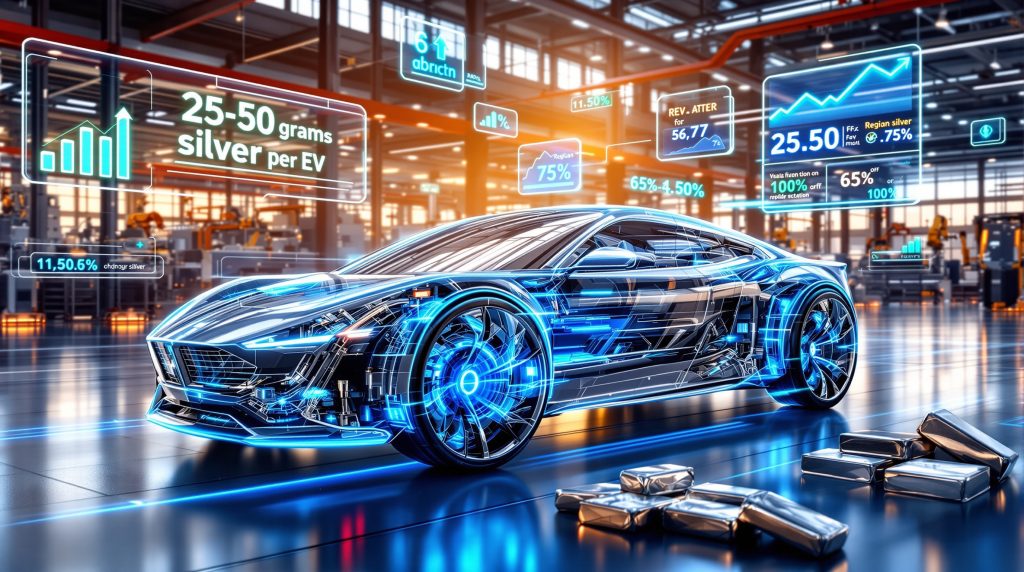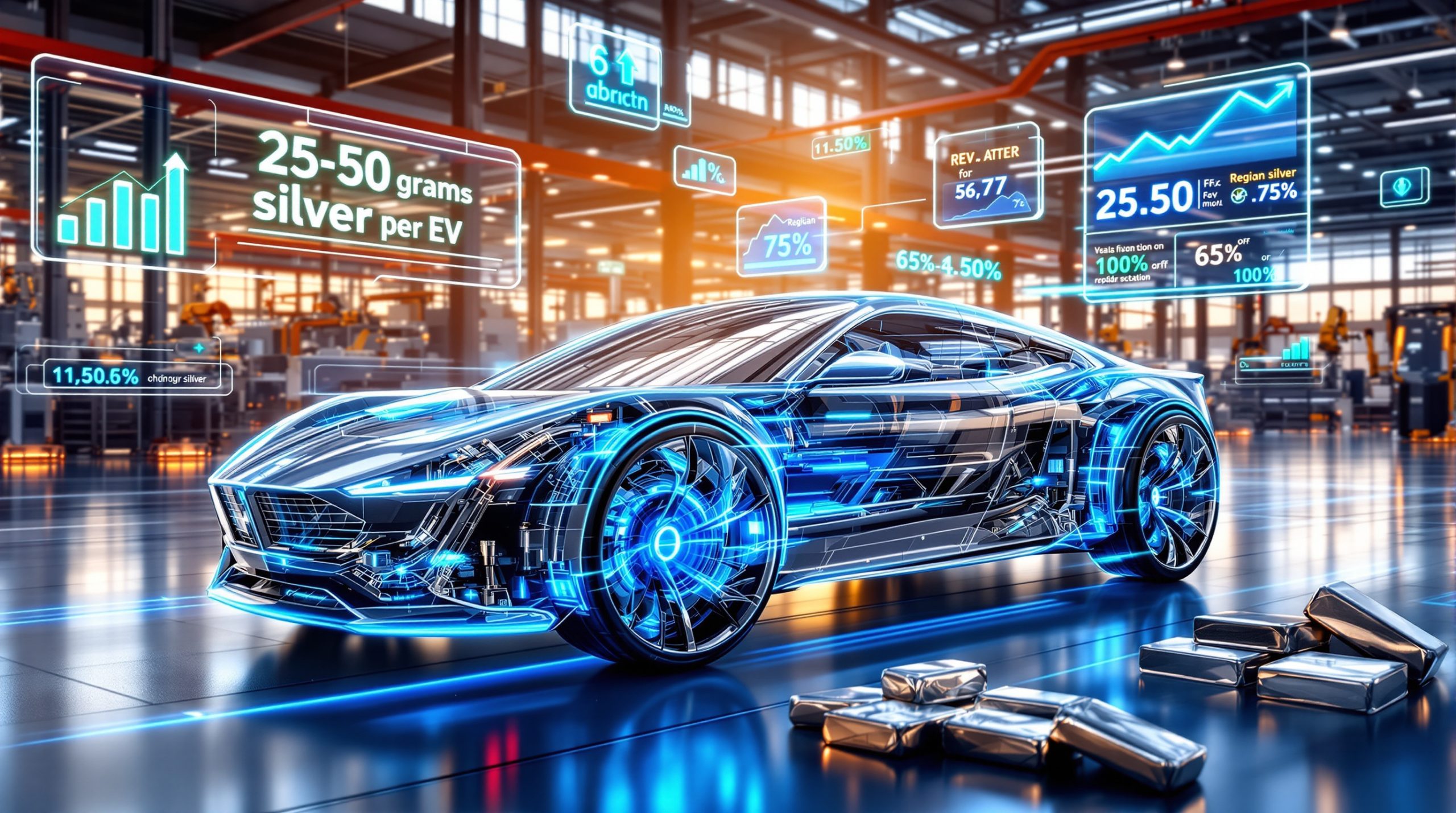Understanding Silver's Critical Role in Modern Transportation
Silver and electric vehicle demand represents a fundamental transformation in automotive silver consumption patterns. Modern EVs incorporate substantially more silver than traditional internal combustion engines due to their complex electrical architectures and sophisticated power management requirements. However, understanding the broader silver market squeeze dynamics provides crucial context for this relationship.
Essential Silver Applications in Electric Vehicle Systems:
• Battery management and thermal regulation circuits
• High-performance electrical contacts and switching mechanisms
• Advanced sensor networks and electronic control units
• Charging port connections and power transfer interfaces
Each electric vehicle contains approximately 25-40 grams of silver based on current industry teardown analysis, representing roughly 2.5 to 4 times the amount found in conventional gasoline-powered vehicles. This increased consumption stems from the higher voltage requirements and more sophisticated electrical systems inherent in EV design.
Advanced Electrical Architecture Requirements
Modern EV electrical systems operate at significantly higher voltages than traditional automotive applications. High-voltage contactors managing 200-600 volts require silver-plated contacts due to the metal's superior arc suppression capabilities and electrical conductivity of 63.01 × 10⁶ S/m at 20°C.
Battery management systems represent another critical silver application area. These sophisticated electronic controllers monitor individual cell temperatures, voltages, and charging states across battery packs containing hundreds of individual cells. The printed circuit boards and connectors in these systems typically incorporate 2-5 grams of silver through specialised conductive inks and plating processes.
Furthermore, the EV mining transformation is creating new supply chain dynamics that affect silver availability. Consequently, understanding these interconnected systems becomes essential for market analysis.
"While silver remains the preferred material for high-voltage applications, automotive manufacturers are actively developing alternative materials and hybrid designs to reduce silver dependency as production scales increase."
How Much Silver Does the EV Revolution Actually Need?
Current market dynamics reveal both opportunities and challenges for silver and electric vehicle demand. Global EV sales reached approximately 14-16 million units in 2024, with projections suggesting continued growth despite recent moderation in adoption rates.
Current Market Metrics (2024-2025):
| Metric | Volume | Growth Trajectory |
|---|---|---|
| Global EV Sales | 14-16 million units | Moderating from previous explosive growth |
| Silver per EV | 25-40 grams average | Declining through technological optimisation |
| EV-Specific Silver Demand | 12-15 million ounces annually | Represents portion of total automotive consumption |
Regional Market Penetration Analysis
Electric vehicle adoption varies dramatically across global markets, creating uneven demand patterns for silver consumption. Moreover, these patterns directly influence silver supply deficits on a global scale.
China: Achieved 40-42% new energy vehicle penetration in 2024, though growth rates have decelerated from the 40%+ expansion seen in 2022-2023 to approximately 9-12% year-over-year growth
Europe: Market penetration declined to 16-18% in 2024 from previous highs of 24%, reflecting reduced government incentives and economic pressures
United States: Battery electric vehicles represent 6.1% market share, with total new energy vehicles reaching 9.8% adoption rates
Emerging Markets: Adoption remains limited at 4-6%, concentrated in specific urban markets with supporting infrastructure
The deceleration in adoption rates across mature markets suggests the EV industry is transitioning from an explosive growth phase to a more sustainable replacement cycle. This shift has material implications for industrial silver demand projections.
Manufacturing Reality vs. Market Projections
Automotive manufacturers have significantly adjusted their electrification strategies over the past two years. Ford postponed its next-generation electric pickup to 2026 and converted the Oakville plant from EV production back to gasoline-powered super-duty trucks. Mercedes-Benz extended internal combustion engine production timelines well into the next decade, moving away from their previous 2030 full-electric commitment.
These operational changes reflect underlying market realities rather than temporary setbacks. Consumer adoption patterns, infrastructure limitations, and economic pressures are driving more conservative production planning across the automotive sector. Additionally, these changes affect silver pricing strategies across the industry.
What Makes Silver Irreplaceable in Electric Vehicle Technology?
Silver's unique physical properties create specific performance advantages in automotive electrical applications, though the concept of "irreplaceability" requires careful examination in the context of cost optimisation pressures.
Technical Performance Characteristics:
• Highest electrical conductivity among all metals (429 W/m·K thermal conductivity)
• Superior arc suppression in high-voltage switching applications
• Excellent corrosion resistance in automotive operating environments
• Reliable performance across temperature ranges from -40°C to +85°C
Alternative Material Development
Despite silver's superior properties, industry data indicates approximately 2-3% annual substitution with alternative materials in automotive applications. These alternatives include palladium-silver alloys achieving 90% of silver's performance at 40% cost reduction, and nickel-based composites suitable for lower-voltage hybrid systems.
The automotive industry's cost optimisation pressures consistently drive material substitution even when performance is marginally reduced. Manufacturing economies of scale favour standardised alternatives, while redundant system designs can compensate for slightly inferior single-contact properties.
Emerging Low-Voltage Architecture Standards
The automotive industry is developing 48-volt electrical architecture standards that require significantly less silver per vehicle. This emerging standard, approved by SAE International in 2022, uses lower-silver-intensive components while providing efficiency improvements for hybrid and electric vehicle systems.
High-Voltage Contactor Specifications:
• Operating voltage: 200-600V DC
• Current handling: 300-600A peak
• Switching cycles: 100,000-500,000 lifetime
• Contact resistance: 1.59 microohms·cm (99.9% pure silver)
Tesla and BMW patent filings from 2022-2024 demonstrate explicit efforts to reduce silver dependency through distributed contact designs, increased surface areas using lower-silver alloys, and improved thermal management systems that reduce reliance on silver's thermal conductivity properties.
Is the EV Market Growth Sustainable for Silver Demand?
The sustainability of electric vehicle growth presents complex implications for long-term silver and electric vehicle demand patterns. Multiple factors influence both the expansion trajectory and the material intensity of future EV production.
Growth Supporting Factors:
• Government emission standards requiring reduced CO₂ outputs by 2030-2035
• Continued battery cost reductions improving price competitiveness
• Expanding charging infrastructure networks in developed markets
• Corporate fleet electrification commitments from major buyers
Growth Constraining Elements:
• Policy uncertainty with changing political administrations affecting incentives
• Market saturation in early-adopter demographics
• Infrastructure development bottlenecks in secondary markets
• Economic sensitivity reducing luxury vehicle purchases during downturns
Policy Dependency Analysis
Over 70% of electric vehicle purchases in 2024 occurred in markets with active government subsidies. Changes to subsidy programmes correlate directly with adoption rate modifications. Germany's reduction in EV incentives resulted in immediate sales declines, while similar patterns emerged in the UK following policy adjustments.
The current US administration has signalled intentions to revisit electric vehicle incentives and emissions standards, creating policy uncertainty that may affect adoption trajectories through 2025-2028. This policy dependency suggests demand patterns remain vulnerable to political and economic shifts rather than representing purely market-driven adoption.
Technology Optimisation Trends
While total EV unit production may continue expanding, the silver content per vehicle is declining through technological advancement. Modern battery management systems use approximately 15-25% less silver than equivalent systems from 2020-2021 through improved circuit design and alternative materials integration. However, understanding the broader context of silver market recovery helps explain these optimisation pressures.
Manufacturing Efficiency Developments:
• Advanced manufacturing techniques reducing silver waste in connector production
• Hybrid connector designs combining silver contacts with alternative materials
• Recycling programmes recovering silver from end-of-life automotive components
• Solid-state battery research exploring reduced silver requirements
How Does EV Silver Demand Compare to Other Industrial Applications?
Electric vehicle silver consumption represents a relatively small portion of total industrial silver demand, creating important context for market impact analysis. Understanding these proportional relationships helps assess the materiality of EV market changes on overall silver and electric vehicle demand consumption patterns.
Major Industrial Silver Applications (Annual Consumption):
| Application Sector | Silver Consumption | Market Characteristics | Growth Trajectory |
|---|---|---|---|
| Solar Photovoltaics | 200-230 million ounces | Declining per-unit content | Production volume dependent |
| Electronics Manufacturing | 180 million ounces | Mature, steady demand | Gradual technological substitution |
| Automotive (All Types) | 60 million ounces | EV segment growing | Total volume relatively stable |
| Medical Devices | 45 million ounces | Specialised applications | Consistent demand patterns |
Solar Industry Silver Optimisation
The solar photovoltaic sector demonstrates how technological advancement can reduce silver intensity while maintaining production growth. Industry data shows silver content per solar cell declined from approximately 400 milligrams in 2007 to 160 milligrams by 2016, with recent innovations achieving 10 milligrams per watt in advanced cell designs.
Solar panel manufacturers utilise silver paste in conductive grid patterns, but material companies face direct profit incentives to reduce silver content. New formulations using ultrafine silver powders claim 30% silver reduction while maintaining electrical performance, though these innovations require higher silver prices to drive widespread adoption.
Furthermore, the green technology silver demand continues to evolve as manufacturers seek cost-effective solutions whilst maintaining performance standards.
Supply-Demand Equilibrium Analysis
The silver market has experienced supply deficits for five consecutive years, though the scale and sustainability of these deficits require careful examination. Total global silver demand reached approximately 1.12 billion ounces in 2024, while mine production and recycling provided roughly 960-980 million ounces of supply.
Critical Supply Considerations:
• Above-ground silver inventories remain substantial relative to annual consumption
• Recycling rates for electronic silver continue improving with higher prices
• Mining production can respond to sustained price increases over 2-3 year periods
• Investment demand (bars and coins) represents 25-35% of total demand and exhibits high volatility
The electric vehicle segment's 12-15 million ounces of annual silver consumption represents approximately 1.1-1.3% of total silver demand, limiting its ability to drive commodity-scale price movements independently of other industrial applications.
What Investment Opportunities Does EV Silver Demand Create?
The intersection of electric vehicle adoption and silver market dynamics presents several investment considerations, though the scale and sustainability of these opportunities require realistic assessment based on current market data. Moreover, understanding silver's role in clean energy provides crucial context for potential opportunities.
Direct Silver Exposure Strategies:
• Physical silver holdings through coins, bars, or exchange-traded funds
• Silver mining equity positions in companies with automotive supply exposure
• Precious metals streaming companies with diversified silver revenue
• Futures contracts or options providing leveraged commodity exposure
Automotive Supply Chain Opportunities
Companies specialising in electrical components for automotive applications may offer indirect exposure to electric vehicle silver demand growth. However, these businesses face the same technological optimisation pressures that reduce silver intensity per unit produced.
Supply Chain Investment Considerations:
Valeo developed 48-volt power distribution systems using nickel-based contacts, reducing silver content by 60% whilst maintaining acceptable performance. Amphenol Corporation introduced hybrid connector designs combining silver with nickel-palladium alloys, achieving 25-30% silver reduction per connector.
These developments illustrate how automotive suppliers actively work to reduce silver dependency, potentially limiting long-term demand growth even as unit volumes increase.
Risk Assessment Framework
Technology Disruption Risks:
• Alternative materials achieving comparable performance at lower costs
• Manufacturing process improvements reducing silver requirements per unit
• Battery chemistry evolution requiring different electrical architectures
• Solid-state battery development potentially altering silver consumption patterns
Market Adoption Risks:
• Electric vehicle penetration rates moderating from early projections
• Policy changes affecting government incentives and emission requirements
• Economic downturns reducing consumer adoption of premium-priced vehicles
• Infrastructure development constraints limiting market expansion
Supply Response Capabilities:
Silver mining operations can increase production in response to sustained higher prices, typically within 2-3 years. Additionally, recycling rates for electronic silver improve significantly when commodity prices justify recovery economics, creating secondary supply that may offset primary demand growth.
Future Outlook: Where Is EV Silver Demand Heading?
The trajectory of silver consumption in electric vehicle applications depends on the interaction between unit volume growth and technological optimisation reducing silver intensity per vehicle. Current trends suggest a complex dynamic rather than straightforward demand expansion.
Projected Development Scenarios:
Conservative Case: Electric vehicle adoption continues at moderated growth rates (5-7% annual market penetration increases) whilst silver content per vehicle declines 2-3% annually through technological advancement
Aggressive Growth Case: Policy mandates accelerate EV adoption beyond current trajectories whilst silver requirements remain stable or increase through advanced battery technologies
Technology Disruption Case: Breakthrough developments in solid-state batteries or alternative electrical architectures significantly alter silver consumption patterns
Autonomous Vehicle Integration
Advanced driver assistance systems and autonomous vehicle technologies may create additional silver demand through expanded sensor networks and computational systems. However, these applications typically use small quantities of silver compared to high-voltage power systems, limiting their material impact on total consumption.
Emerging Technology Applications:
• Vehicle-to-grid energy storage integration requiring additional electrical interfaces
• Wireless charging infrastructure development using silver-plated components
• Advanced battery thermal management systems with silver-based heat dissipation
• Smart city integration technologies connecting vehicles to infrastructure networks
Manufacturing Consolidation Effects
As electric vehicle production scales increase, automotive manufacturers gain greater negotiating power with suppliers and stronger incentives to optimise material costs. This consolidation dynamic historically drives material substitution and efficiency improvements across automotive supply chains.
Industry analysis suggests that whilst total EV unit production may double over the next decade, total silver consumption from the automotive sector could remain relatively stable due to continued technological optimisation and alternative material adoption.
Key Takeaways for Understanding Silver and EV Market Dynamics
The relationship between electric vehicle adoption and silver demand represents a nuanced market dynamic rather than a straightforward growth story. Several critical factors shape this relationship and its investment implications.
Market Reality Assessment:
-
Scale Limitations: Electric vehicle silver demand represents 1.1-1.3% of total silver consumption, limiting its ability to drive commodity prices independently
-
Technology Trajectory: Silver content per vehicle is declining through optimisation, potentially offsetting unit volume growth
-
Policy Dependency: EV adoption rates remain heavily dependent on government incentives rather than organic market demand
-
Regional Variation: Adoption patterns vary dramatically across markets, creating uneven demand distribution
Investment Framework Considerations:
Electric vehicle silver demand offers exposure to the clean energy transition, but investors should maintain realistic expectations about scale and sustainability. The automotive industry's consistent pattern of material cost optimisation suggests silver intensity per vehicle will continue declining even as unit production grows.
Critical Success Factors for Silver Demand:
• Sustained Policy Support: Government emission standards and incentives must persist through political cycles
• Technology Stability: Silver-intensive applications must remain cost-effective versus emerging alternatives
• Supply Chain Economics: Mining production and recycling must address structural deficits without eliminating price incentives
• Market Maturation: EV adoption must transition from subsidy-dependent to economically self-sustaining demand
Strategic Perspective:
The electric vehicle revolution creates opportunities for silver demand growth, but technological advancement and cost optimisation pressures create countervailing forces. Investors considering silver exposure through EV demand growth should evaluate the complete market dynamic rather than focusing solely on unit volume projections.
The evidence suggests that whilst electric vehicle adoption will continue, its impact on silver markets may be more modest than initial industry projections indicated. This reality creates both opportunities and risks for investors seeking exposure to the intersection of clean energy adoption and precious metals demand.
Understanding these market dynamics requires acknowledging both the growth potential and the optimisation pressures that shape industrial silver consumption patterns. The most successful investment approaches will likely account for both factors rather than assuming linear demand growth from electric vehicle adoption alone.
Ready to Invest in the Next Major Mineral Discovery?
Discovery Alert instantly alerts investors to significant ASX mineral discoveries using its proprietary Discovery IQ model, turning complex mineral data into actionable insights. Begin your 30-day free trial today to position yourself ahead of the market and understand why major mineral discoveries can lead to substantial returns.




